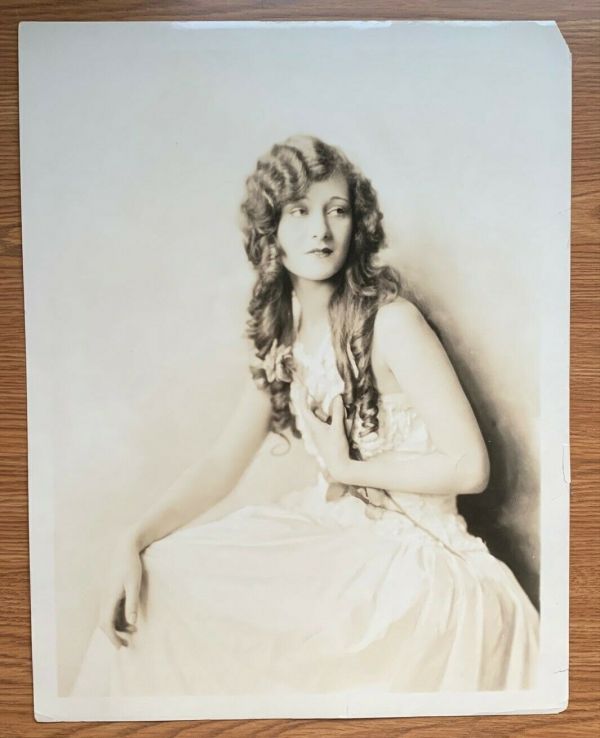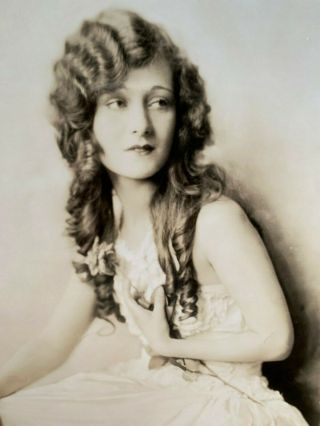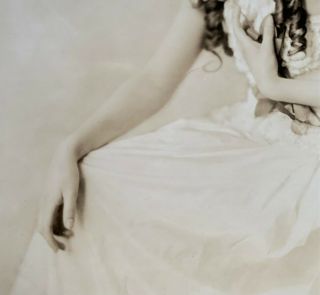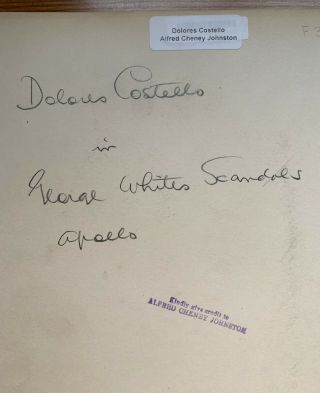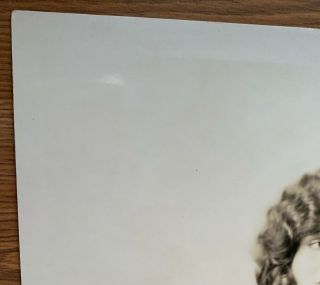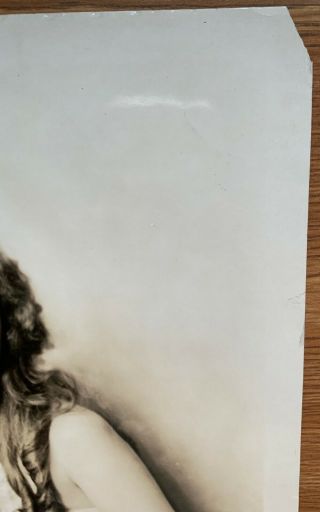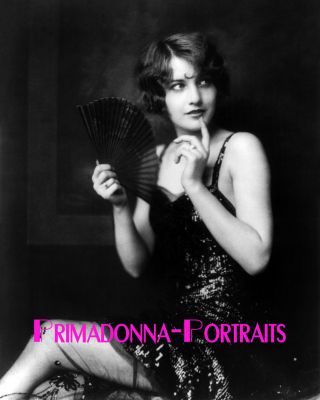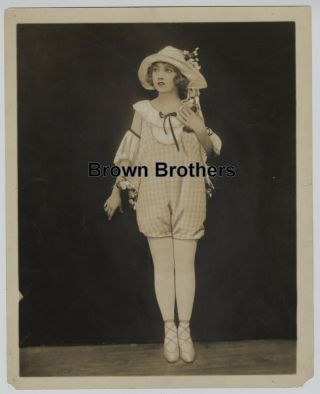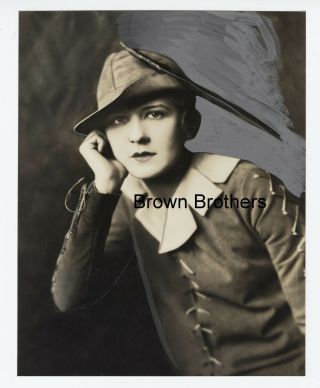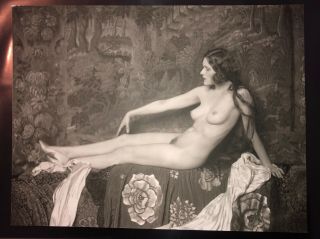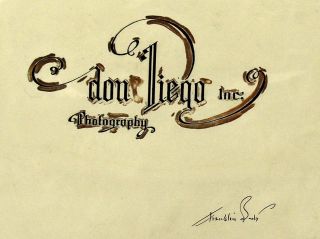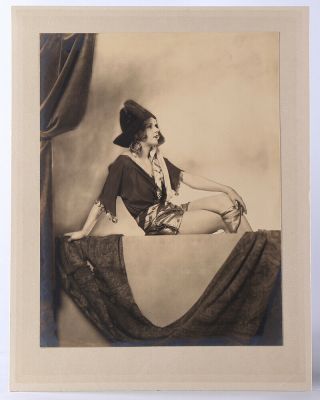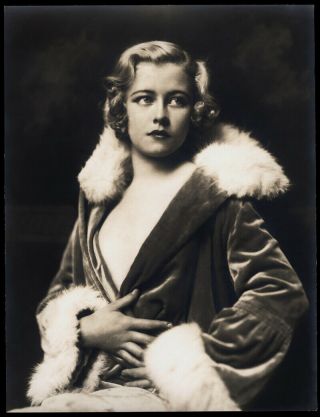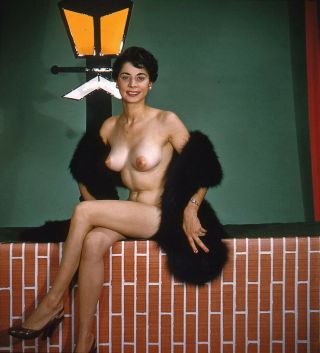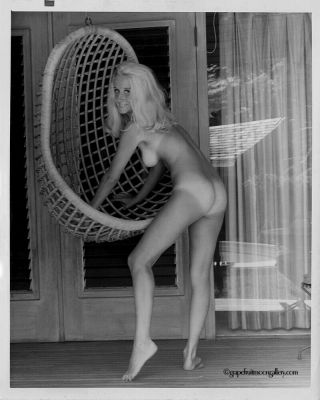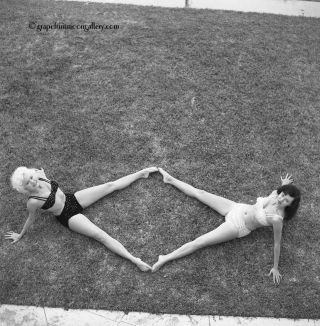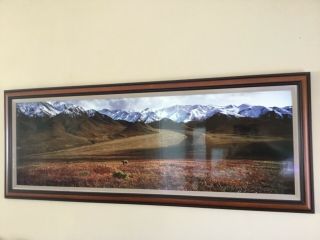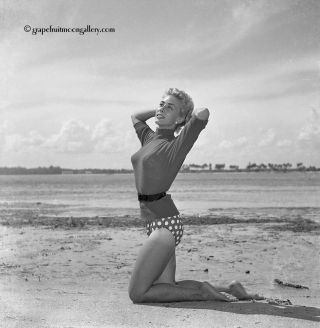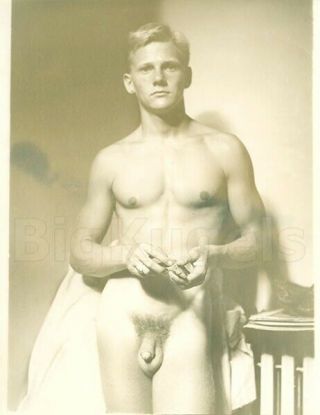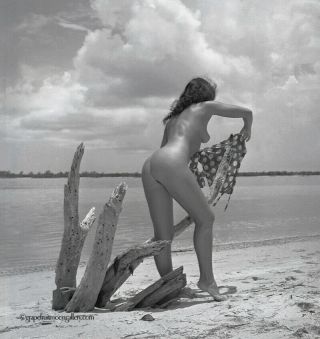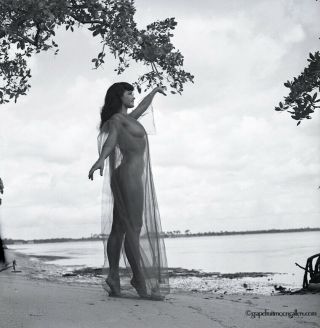DOLORES COSTELLO / ALFRED CHENEY JOHNSTON / 1924 B ' Way George White ' S Scandals
Item History & Price
A stunningly beautiful portrait of DOLORES COSTELLO taken by ALFRED CHENEY JOHNSTON. It measures 11" x 14" / Look carefully at the pics. There is some tape and some minor loss on some corners. The corner pics caught a glare, my apologies. Lovely for framing, as wear and tear is on the border. And, again, a stunning picture. MR. JOHNSTON'S stamp is clearly seen on the back.
This was taken in 1924 when she was appearing in George White's Scandals (Jun 30, 1924... - Dec 13, 1924)
George White's Scandals (1924) had music by George Gershwin. Also featured in the cast was Louise Brooks.
The production was at the Apollo Theatre, 223 W. 42nd St., New York, NY. Built in 1910 as the Bryant, 42nd Street's first motion picture and vaudeville house and held 2000 people. In 1920, the Selwyn brothers rebuilt it (Eugene De Rosa, architect) as a legit house, the Apollo. From November 1934 to 1937, burlesque was produced, until the Brandt chain took over. By 1938, it was a popular art and foreign movie house. 1979 to 1983 marked a brief return to legit theatre. Later, it held rock concerts. It was demolished in 1996. Architectural elements from the building were incorporated into the Ford Center in 1998.
LADIES AND GENTLEMEN, ALFRED CHENEY JOHNSTON:
Time Period: 1917-1939
Location: Hotel de Artistes, Manhattan; 1 W. 67th St.
Alfred Cheney Johnston (1884-1971) was born into a New York banking family. Educated as a painter and illustrator at the National Academy of Design in New York City, he attracted the notice of Charles Dana Gibson. Shortly after graduating, he married in 1909 and for this reason did not serve in World War I. Johnston was cavalier about the information he dispensed about his beginnings. One myth, captured in a feature story about him in the Bridgeport Sunday Post of March 4, 1951, had him training at the Art Students League, photographing a student, and being hired by Ziegfeld when the sitter's family showed the image to the producer. According to legend, Ziegfeld invited him to the Midnight Frolic, looked over the portfolio, contracted with him and said, "Let's go back and meet the girls." In truth, shortly after his graduation from the Academy in 1908, Johnston attempted to become a portrait painter and failed. He took up the camera which he had used as an aid in his painting setups and made it the instrument of his art. He supported his wife by working as an uncredited retoucher and later camera artist for Sarony Studio.
By 1915 he had become one of the two chief photographers working for the most famous theatrical photography company in New York. Florenz Ziegfeld, taken with Johnston's portraits of showgirls in the 1915 and 1916 Follies and with two portrait sessions of Billie Burke, his wife, that were published in Vanity Fair, hired Johnston to photograph his theatrical enterprises. There was no long term contract--rather Johnston was paid by the job, a fact he revealed to newspaper columnist Charles B. Driscoll in 1938 when on the verge of retirement. Driscoll asked Johnston whether he ever had difficulty getting paid by Ziegfeld (an endemic problem for talent contracted for the Follies). "I know he often failed to pay bills, but in my case there was no difficulty. I was employed by the job. He would ask me to take on the work for a forthcoming production. We would agree on a price. So much work for so much money. He never quibbled over cost, and I was paid promptly."
Johnston's name appeared next to images for the first time in 1917. His portraits of showgirls in that year's edition of the "Follies" were featured conspicuously in the summer issues of Vanity Fair. They created a sensation. Thereafter, his images appeared in many of the important magazines: Photoplay, Motion Picture Classic, Shadowland, and The Theatre. Shooting primarily in his studio, Johnston became famous as the foremost chronicler of feminine beauty of the period. Movie stars, Broadway headliners, and society women come to be "glorified" by Johnston's camera. In 1918, Johnston developed a second career as an advertising photographer and became an important figure in the history of male fashion photography with his ad campaign for Dobbs Hats.
In 1920, shortly after James Abbe had contracted to work for Mack Sennett in Hollywood, Johnston allowed himself to be persuaded by director Allan Dwan to go West. Dwan, who was raiding the Follies for Jacqueline Logan, promised Johnston work as a still photographer, lighting designer, and wardrobe consultant. Johnston arrived in Los Angeles in November 1920, shot stills and publicity on "A Perfect Crime" and "The Forbidden Thing, " as well as numbers of portraits before the factory mentality of the studio drove him back East. Throughout the 1920s, he would be contracted for special production images for motion pictures, most frequently on movies designed by his friend and colleague at the Follies, Joseph Urban. With the exception of four images, these stills did not bear his name in print. At the same time, he privately experimented with color processes. His professional colleagues, out of respect for his artistry and technical prowess, made Johnston a trustee of the New York Camera Club in 1926.
When Ziegfeld died in 1932, Johnston's fame as a camera artist and commercial photographer was such that he weathered the Depression with little difficulty. In 1930, he became associated with Broadway producer-director, Alexander Leftwich, serving on his production team as art director for the musicals "Dollars Up" and "Daisies Won't Tell" which Johnston co-produced with Leftwich. Johnston incorporated himself on December 3, 1931, and began the direct sales of his nudes to the public, broadened his commercial work, and provided lighting design credited ["Sea Legs"] and uncredited for several Broadway productions.
In October of 1934 the Smithsonian Institution exhibited a selection of his portraits which garnered extravagant praise in the press. In 1937 Swan Publishing Co. of New York City issued a collection of Johnston nudes, Enchanting Beauty. It sold for 75 cents. Johnston retired in 1939 to Connecticut. In 1941 he revisited Hollywood, pondering the possibility of studio work. The studio system of publicity production still did not appeal to him, so he again returned East and "became an amateur." He died thirty-two years later in 1971. Shortly thereafter, in January of 1973, the Library of Congress mounted a memorial exhibition of his portraits. ~ David S. Shields/ALS
Specialty:
Johnston, while renowned for his glamour portraits of Ziegfeld girls and actresses, was a versatile artist adept at visualizing advertising imagery, urban landscapes, color still lifes, and production shots. Johnston was one of the creators of 20th-century glamour photography, giving his sitters erotic allure while vesting them with dignity and power. While his celebrity portraiture predominantly pictured women, his commercial imagery, particularly his famous campaign for Dobbs Hats projected masculine elegance. He was known in New York photographic circles for his color still lifes as well, though these never appeared in magazines.
His nude photography redefined the genre, creating a refimed visual erotics differing from the vulgar French postcard and the misty nude dancers of pictorial photography. His late book, Enchanting Beauty, marked a departure from his early work, manifesting the surrealism and visual wit of Manasee studio in Vienna, and presenting visual homages to the nude styles of E.B. Hesser and Nickolas Muray. Johnston's approach to his photographic work was painterly. Indeed, in a significant number of his portrait and erotic images he painted backgrounds directly on the negative. What appears to be as painted backdrop or patterned wall is a semi-abstract impression hand rendered on the glass or film.
Johnston rarely discussed his photographic methods in print, and aside from professional talks on color processes, his public pronouncements about his photography tended to be recollections of shooting Ziegfeld showgirls and motion picture stars. Yet in one revealing interview with Violet Dare published in 1928, he spoke candidly about many of the dimensions of his art. "I just work in my own way . . . I don't imitate the methods of anyone else. And I break all the laws of photography whenever I see fit--not that I can see their value anyway! Why insist on having a shadow here and a high light there, simply because books have been written saying that you must? I suit everything to the personality of the person whose picture I'm making. Lights, background, composition-everything! I like to have a little talk with the person I'm going to photograph, before we get to work, two or three days before perhaps. We sit down here and talk things over, and I find out what kind of pictures are desired, and all that sort of thing. You see, a girl who wants to go into pictures or get on the stage, or who is already famous, perhaps, but needs new photographs, must have several kinds. She needs straight heads, full length pictures, some beautifully draped, some taken in decorative costumes. Her pictures must appeal to the editors of magazines and newspapers, as well as to theatrical producers. They are a large part of her stock in trade. I talk over her good points with her, suggest costumes, perhaps, though I always try to leave as much as possible to the girl herself. I don't believe a photographer should try to do the whole thing in his own way. If he does, he's going to get the same sort of pictures of everybody! Then, when I actually take the pictures, as I've said before, I suit everything to the sitter's personality. There's a great deal in having the right sort of lighting, of course. The background means a great deal. Take a picture of a draped figure, for instance. It may be rather coarse, unattractive, if it is done in the wrong way. But if the drapery is beautifully arranged, if the whole thing is made to look natural and simple, and the background which I paint into the negative harmonizes, the result is going to be beautiful. . . . I try to make not just a photograph of a girl's face and figure, but one of her personality as well, because when you look at a person your eye isn't photographic. You don't see just the features. In fact, you probably couldn't describe your best friend's face absolutely accurately, could you? You'd remember characteristics, interesting attributes, that would temper that memory. That's why photographs so often are disappointing--they show just what the eye sees. But take a photograph that has a definite atmosphere, that brings out a girl's elfin loveliness, her daintiness, her quiet, sweet charm, her spirit of gay camaraderie, and you've got a photograph that is going to mean something to her and her friends."
[Violet Dare comments on the beauty of the backgrounds and asks about them.] "I paint them in. . . . You see I studied art for ten years before I even thought of making photographs. I can't get away from it, of course. Now, the composition of a picture means a great deal. Take this, for instance ('this' being a picture of a pretty girl in a bit of black chiffon and lace, a charming piquant thing). Look at just the figure, without anything else; not so very nice, is it? But-with the drapery on the wall here, and this spray of leaves down the other side, the whole thing becomes more like a painting. . . . Take a woman in everyday life, a very beautifully gowned woman, say a dowager on her way to a wedding. Let her stand in the middle of a crowded elevator in a cheap department story. Instantly she is out of place, the effect of her manner, her gown, her breeding, is likely to be discounted, isn't it? She's in the wrong environment. Well, in my photographs I try to create the proper environment, just as we try to create it for ourselves in real life." ~ Violet Dare, "Is Your Beauty Invisible, " Wheeler Syndicate, 1928.
WHO IS DOLORES COSTELLO:
Dolores Costello (September 17, 1903 – March 1, 1979)was an American film actress who achieved her greatest success during the era of silent movies. She was nicknamed "The Goddess of the Silent Screen". By her first husband, the actor John Barrymore, she was the mother of John Drew Barrymore and the grandmother of Drew Barrymore.
Dolores Costello was born in Pittsburgh, Pennsylvania; the daughter of actors Maurice Costello and Mae Costello (née Altschuk). She was of Irish and German descent. She had a younger sister, Helene, and the two made their first film appearances in the years 1909–1915 as child actresses for the Vitagraph Film Company. They played supporting roles in several films starring their father, who was a popular matinee idol at the time. Dolores Costello's earliest listed credit on the IMDb is in the role of a fairy in a 1909 adaptation of Shakespeare's A Midsummer Night's Dream.
The two sisters appeared on Broadway together as chorines and their success resulted in contracts with Warner Brothers Studios. In 1926, following small parts in feature films, she was selected by John Barrymore to star opposite him in The Sea Beast, a loose adaptation of Herman Melville's Moby-Dick. Warner Bros. soon began starring her in her own vehicles. Meanwhile, she and Barrymore became romantically involved and married in 1928.
Within a few years of achieving stardom, the delicately beautiful blonde-haired actress had become a successful and highly regarded film personality in her own right. As a young adult her career developed to the degree that in 1926, she was named a WAMPAS Baby Star, and had acquired the nickname "The Goddess of the Silver Screen". Warners alternated Costello between films with contemporary settings and elaborate costume dramas. In 1927, she was re-teamed with John Barrymore in When a Man Loves, an adaptation of Manon Lescaut. In 1928, she co-starred with George O'Brien in Noah's Ark, a part-talkie epic directed by Michael Curtiz.
Costello spoke with a lisp and found it difficult to make the transition to talking pictures, but after two years of voice coaching she was comfortable speaking before a microphone. One of her early sound film appearances was with her sister Helene in Warner Bros.'s all-star extravaganza, The Show of Shows (1929).
Her acting career became less a priority for her following the birth of her first child, Dolores Ethel Mae "DeeDee" Barrymore, on April 8, 1930, and she retired from the screen in 1931 to devote time to her family. Her second child, John Drew Barrymore, was born on June 4, 1932, but the marriage proved difficult due to her husband's increasing alcoholism, and they divorced in 1935.
She resumed her career a year later and achieved some successes, most notably in Little Lord Fauntleroy (1936), and The Magnificent Ambersons (1942). She retired permanently from acting following her appearance in This is the Army (1943), again under the direction of Michael Curtiz.
Making a rare radio appearance, Costello appeared as the Danish Countess Elsa on the radio program Suspense with an air date of August 28, 1943. The title of the episode is The King's Birthday written by Corporal Leonard Pellitier US Army.
In 1939, she married Dr. John Vruwink, an obstetrician who was her physician during her pregnancies, but they divorced in 1950. Costello spent the remaining years of her life in semi-seclusion, managing an avocado farm. Her film career was largely ruined by the destructive effects of early film makeup, which ravaged her complexion too severely to camouflage. Her final film was This Is the Army (1943). In the 1970s her house was inundated in a flash flood which caused a good deal of damage to her property and memorabilia from her movie career and life with John Barrymore.
Shortly before her death, she was interviewed for the documentary series Hollywood (1980) discussing her film career. She died from emphysema in Fallbrook, California, in 1979, and is interred in Calvary Cemetery, East Los Angeles.
Dolores Costello has a star on the Hollywood Walk of Fame for her contributions to Motion Pictures, at 1645 Vine Street. ~ Wiki
HERE IS ANOTHER BIO OF DOLORES COSTELLO:
Dolores Costello was born September 17, 1905, in Pittsburgh, Pennsylania. Her father, Maurice Costello, was a theatrical star for 15 years before becoming a famous and extremely popular matinee idol of the young silver screen, appearing in dozens of films on the East Coast at the Edison Studios, and then at Eastern Vitagraph Studios.
When a small child was needed in one of his movies, Maurice, who was publicized as the “Dimpled Darling, ” made sure his daughter Dolores or her younger sister Helene got the role. In 1908, when Dolores was three, she made her film debut at Edison playing a little boy, and a year later she played a fairy in A Midsummer Night’s Dream (1909).
Later, Dolores won roles in twelve Vitagraph films between 1911-1914.
Dolores spent the rest of her childhood in a private school, but once in her teens, the ethereal, stunning blonde left home for modeling school in New York City. She soon posed for renowned fashion designer James Montgomery Flagg, who turned her into the most sought after and celebrated model of the time.
Eventually, Helene followed her sister to New York and in 1924 they both became chorus girls on Broadway, dancing together in the famed George White's Scandals. While the show was on tour in Chicago, both sisters were signed to a movie contract with Warner Bros. Studios, and the whole family relocated to Hollywood, where Mother Mae diligently chaperoned her “poor angels.”
In 1925, Dolores appeared in a few average films for Warner Bros. before making the acquaintance of John Barrymore, who, 15 years her senior, became enamored of the beautiful starlet. When the great star, known as “The Great Profile, ” first saw his future wife wandering around the lot he remarked that she was “…the most preposterously lovely creature in the world, a charming child, slender and shy and golden-haired. Never saw such radiance. My God! I knew that she was the one I had been waiting for. Waiting all my life. Just for her."
Barrymore dumped his girlfriend, movie star Mary Astor, and Dolores became John's leading lady in the 1926 silent version of Moby Dick, re-titled The Sea Beast (1926). During one of their lengthy kissing scenes, Costello fainted, and the intriguing image of her lifeless expression and swinging arms were captured on celluloid and kept in the movie.
In 1927, Costello starred with Barrymore again in When A Man Loves. That same year, Mae divorced Maurice, and Dolores won the lead role in Old San Francisco (1927), a movie dealing with race relations during the great 1906 earthquake. The following year, her sister Helene appeared in the first all talking picture, Lights of New York (1928). Helene's voice was deemed inadequate for sound films, and she quickly faded from view while Dolores, who had worked for two years with a speech therapist to correct her severe lisp, became one of the first stars in talking pictures at Warner Bros. Studios. Helene died in 1957.
Dolores Costello married John Barrymore in 1928. They had two children, John Drew and Dede. The star promoted his wife's career relentlessly. She in turn put up with the public exploits of her famous, alcoholic, and abusive husband. Barrymore stated, “Why is it that such a lovely girl as Dolores has to have a mother?”
Mae died in 1929. That year Costello starred in Noah's Ark (1929). The special effects in the movie are still spectacular today. During the filming of one violent and uncontrolled scene, six extras drowned and Costello contracted pneumonia after hours of wading in cold water. Other films she starred in were Show of Shows (1929), and Second Choice (1930). After appearing in Expensive Women (1931), she took time off to raise her children.
In 1935, Costello divorced Barrymore, and the next year she returned to her career in Little Lord Fauntleroy (1936). In 1939, she married her obstetrician Dr. John Vruwink, who John had accused her of having an affair with during their marriage. Also that year, her widowed father Maurice, who had attempted various comebacks through the years but was now long forgotten in the film world, sued both his daughters for support, and the sixty-two year old performer married thirty-year-old Ruth Reeves, who filed for a Tijuana divorce two years later citing him as "unreasonably and insanely jealous."
In 1940, the once rich and famous Maurice Costello took a role as an extra for $12.50 a day in the musical film Tin Pan Alley (1940), starring Alice Faye and Betty Grable. He died in retirement in 1950, after four years at the Motion Picture Country House where his estate was valued at under $100.
In 1942, the same year John Barrymore visited Dolores to tell her he was “sorry” not long before he died of a combination of pneumonia and cirrhosis of the liver, Dolores was cast as Isabel Amberson in one of the great films of the 20th century, Orson Welles' The Magnificent Ambersons. It was her last big role.
The lovely Dolores Costello was blessed with a very fair, perfect, and delicate complexion, and she developed severe reactions to the harsh makeup then used in her movies. The skin on her cheeks began to deteriorate, and artists found her condition impossible to hide. Her beauty ravaged, poor Dolores was forced into retirement after her final film, a musical, This Is The Army (1943).
She divorced Vruwink in 1950, the same year her father died, and moved away from Hollywood to live alone on an avacado farm in Fallbrook, a town twenty miles outside San Diego. In 1977 her life was reported in the book Damned in Paradise: The Life of John Barrymore, by John Kobler. Appearing very old and haggard, Costello agreed to various interviews during this time, and she was chronicled in a British miniseries, Hollywood, released in 1980.
Dolores Costello, who made 32 Hollywood films, and was the grandmother of actress Drew Barrymore, died from emphysema, after a long illness, at age 73, March 1, 1979. ~ emol . org
I purchased this about five years ago (?) and have loved looking at it, though is never came out of its plastic sheath until I took it out today to photograph. I have quite a number of Alfred Cheney Johnston's work, and am ready to part with a few. I know that Ms. Costello will find a lovely home!



